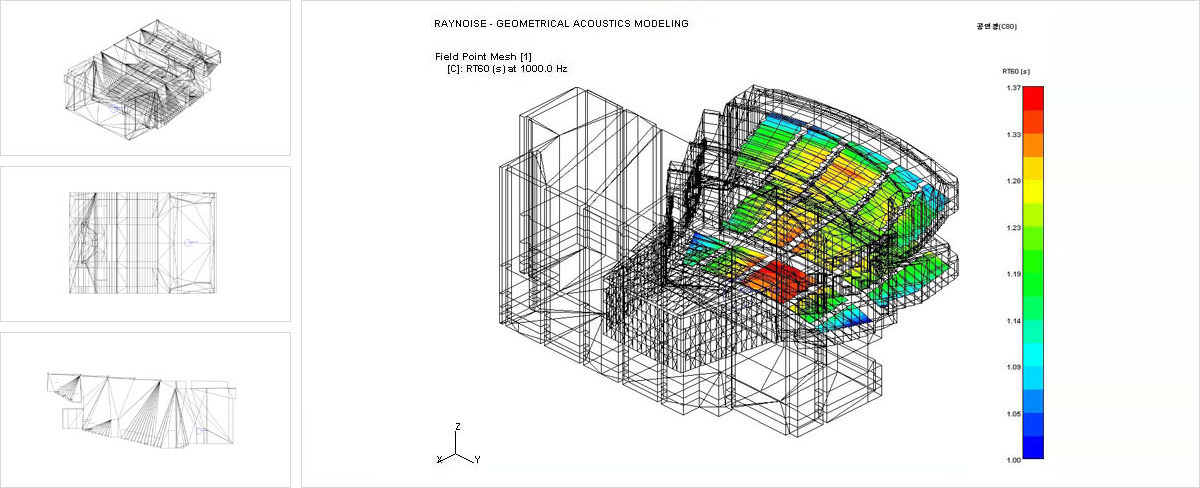Prediction and analysis of the sound pressure distribution and indoor acoustic parameters of the target building is a method to determine the indoor acoustic performance
using the 3D computer simulation method by the ray-tracing method and the image model method.

Reverberation time (RT, sec)
In a free sound field space without obstacles, the generated sound will be gradually attenuated as it propagates far away, and when the sound generation stops, the sound
propagation will also stop. However, in the room, the sound generation does not stop and the afterglow remains. In other words, the lingering sound left when sound
generation is stopped in the room is called reverberation. The measurement of the time at which the intensity of the lingering sound attenuates to 60 dB from the beginning
when the sound generation ceases is called RT60. However, since it is rare to attenuate up to 60 dB in reality, the time to attenuate up to 30 dB is sometimes doubled, and in
that case, it is defined as T30. Since the physicist WCSabine published a study in 1895, it has been used as an important factor in evaluating indoor acoustic environments.
Sound Pressure Level (SPL)
When an object vibrates, atmospheric pressure changes due to this vibration, and this change causes the eardrum to vibrate and is heard as sound. That is, sound is a
pressure change in atmospheric pressure, and this fluctuation part is called sound pressure, and represents the physical size of sound.
The sound pressure level is a unit that measures the continuous sound intensity. In general, the average sound pressure level in face-to-face communication is about
65 dB(A), and 70 to 75 dB(A) in a meeting in a quiet environment. degree is required In other words, if the sound pressure level is too low, it is difficult to understand, so
satisfaction is lowered, and if the sound pressure level is higher than the optimal sound pressure level, it is too loud and causes discomfort, so the satisfaction level is lowered.
Speech intelligibility (D50 Definition, %)
It is the ratio of direct sound to indirect sound (reflected sound), and % is used as a unit. The early reflection sound up to about 50 ms has the effect of reinforcing the size of
the direct sound and increasing the clarity, so it is indicated as D50. This D value increases as the number of short delayed reflections increases, the reverberation time
decreases, and the volume of the room decreases, so clarity improves. If this value is large, the intelligibility is high, and if the value is small, the intelligibility is low and the
amount of reverberation is large.
The appropriate D value for a multi-purpose theater is about 55 to 60%, and it is said that 30 to 40% is appropriate for a concert hall.
Music Clarity (C80 Clarity Index, dB)
Similar to D50 (Definition), the C80 value, which is a Clarity Index, was proposed by Reichart et al. to indicate the clarity of music in a concert hall. Compared to 50 ms in D50,
C80 uses 80 ms as the delay limit, which is a difference because reflections in music are less perceptible than conversational sounds. He set the permissible value of C80
within the music hall as ±2 dB. However, in a space with a large space such as an outdoor stadium and many reflective finishes, a slightly wider range of values is obtained
than the C80 in an indoor space.

The evaluation of C80 is as follows
1) 0/-2dB: Clarity value that should be obtained in organ music and romantic music
2) +2/-2dB: Value ideal for classical or symphonic instrumental music and suitable for traditional church music
3) +4/ -2dB : Suitable for fast modern music, suitable for folk music, modern church music, popular music, and jazz.
4) +6/-2dB : Value for clear listening to fast rock and roll.









